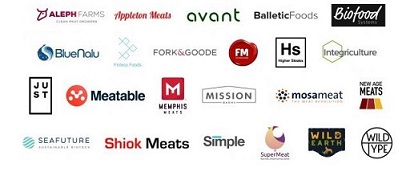Cultured Meat; manufacturing of meat products through "tissue-engineering"
technology.
In-Vitro meat is the (idea of) manufacturing of meat products through "tissue-engineering"
technology. Cultured meat (= in-vitro meat = clean meat) could have financial,
health, animal welfare and environmental advantages over traditional
meat. The idea: To produce animal meat, but without using an animal.
Starting cells are taken painlessly from live animals, they are put
into a culture media where they start to proliferate and grow, independently
from the animal. Theoretically, this process would be efficient enough
to supply the global demand for meat. All this would happen without
any genetic manipulation, i.e. without the need to interfere with
the cells’ genetic sequences.
Producing cultured meat for processed meat products, such as sausages,
burgers and nuggets should be comparatively simple, whereas cultured
meat which should be more highly structured, such as for an in-vitro
steak is considerably more of a challenge. A steak is made of muscle
tissue which is threaded through with extremely long, fine capillaries
which transport blood and nutrients directly to the cells. It is much
more difficult to reproduce such a complex structure than it is to
put together the small balls of cells which grow to larger balls of
cells which in turn become in-vitro chicken nuggets.
The most important challenges to overcome in order to outperform animal
derived meat in terms of taste and economics are:
Starter Cells:
These can be taken painlessly from live animals via biopsy. The question
is: Which type of cells should be used? Stem cells are cells which,
in a manner of speaking, have not yet decided what they will become;
muscle cells, bones cells or one of so many other kinds of cells?
This is a disadvantage because very specific cells are needed for
the production of in-vitro meat. However, the advantage of stem cells
is that they proliferate rapidly. The alternative to using stem cells
would be to use fully defined muscle cells that “know what they
are” although the problem here is that they hardly multiply
at all. A compromise is to use cells which are between the two extremes,
in other words, cells that proliferate at an acceptable pace and that
are at the same time sufficiently differentiated from other cell types,
for example, myoblast cells.
Growth Medium / Culture Media:
The aim is to find a medium in which the cells can grow that is cost
effective and free from animal ingredients. Serum from calves, for
example, cannot be used with cultured meat. Because cultured meat
does not have the digestive organs that a live creature has, which
convert nutrients to feed the cells, the medium must be able to supply
the cells directly with what they need.
Material for an edible scaffold for the
cells to attach themselves to:
In order to produce three-dimensional in-vitro meat, it is necessary
to have a scaffold. The ideal is an edible scaffold that would not
need to be extracted from the end product. To simulate the stretching
that muscle cells undergo as a living creature moves around it is
highly desirable to develop a scaffold that could periodically shift
its form thus “exercising” the cells. This could be achieved
by using a stimuli-sensitive scaffold made of alginate, chitosan or
collagen, from non-animal sources. The scaffold would then stretch
periodically in response to small changes in temperature or pH levels.
The cells could also attach themselves to a membrane or tiny beads
which could be layered on top of each other and connected together.
Bioreactor:
It is in the bioreactor that everything comes together; the cells,
the culture medium and the scaffold. Through fluctuations in temperature
an environment is created which can be likened to a fitness centre
with movement training for the muscle cells. Cultured meat must consist
of small and large fibres of muscle cells in addition to connective
tissue which produces collagen and elastin as well as fat cells which
are important for the taste of the end product.
Economically viable solutions for the above listed
points have not yet been fully researched. We are still waiting for
the big breakthrough.
We would like to briefly remark on the idea of
food being natural: It is intended that cultured meat should replace
industrialised intensive farming; this poses no threat or competition
to farming organic vegetables, for example. Compared to the unnaturalness
of industrial animal farming, cultured meat would be undoubtedly
a progressive step in terms of health, animal welfare and ecology.
Status Quo of the global research:
Currently, there are 3 very active countries in the cultured meat research: The USA, mainly California, with companies like "Memphis Meats" or "Hampton Creek / Just " or "Finless Foods" (cultured fish), the Netherlands with"MosaMeat" and last not
least Israel with "Supermeat" and "The Kitchen Foodtech Hub".
Japan could become a further hotspot of research with the open source "Shojinmeat Project".

New
Harvest - one great organisation for promoting cultured meat!
The
Modern Agriculture Foundation - organisation for cultured meat!
The
Good Food Institute - a third great organisation for cultured meat and more!
International In
Vitro Meat Consortium!
InVitroMeat
Foundation
Shorter scientific
paper on status quo of cultured meat research in 2017
Cultivated Meat Report GFI, 2020
People should replace animal meat with cultured meat - US survey 2017
Links to media articles
Startup company
Modern Meadow and 3-D-printed meat (Time Techland)
Video
about cultured meat
$17 million for Memphis Meats from Gates, Branson, Cargill (2017)
The IndieBio-Lab in San Francisco, hot spot of the research (incl. Video)
Video of latest innovations in clean meat (end 2018)


